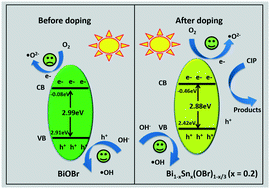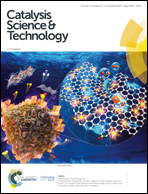Efficient photocatalytic reactions of Cr(vi) reduction and ciprofloxacin and RhB oxidation with Sn(ii)-doped BiOBr†
Abstract
Bismuth oxyhalides (e.g., BiOBr) are promising photocatalysts for the removal of organic contaminants. However, the efficiency of BiOBr is largely limited by its band structure. Here, we have found that Sn2+ doped into BiOBr can modify its band structure; a suitable band structure facilitates the dual catalytic functions of oxidation and reduction, considerably improving the photocatalytic performances. Systematic characterizations suggest that Sn2+ cations were homogeneously dispersed into BiOBr. By varying the doping amount of Sn2+, we found that Bi1−xSnx(OBr)1−x/3 (x = 0.2) catalyst exhibited the highest photocatalytic activity. The elimination rates of Cr(VI) (15 mg L−1) and CIP (20 mg L−1) could reach more than 95% in 60 and 40 min, respectively, under visible-light irradiation. In contrast to bare BiOBr, the degradation rates of Cr(VI) and CIP over Bi1–xSnx(OBr)1–x/3 (x = 0.2) increased by around 45 and 2 times, respectively. The active substances of the Bi1−xSnx(OBr)1−x/3 catalyst and the environmental impact factors during the catalytic degradation of CIP were determined, and two possible degradation routes were proposed.

- This article is part of the themed collection: 2019 Catalysis Science & Technology HOT Articles


 Please wait while we load your content...
Please wait while we load your content...